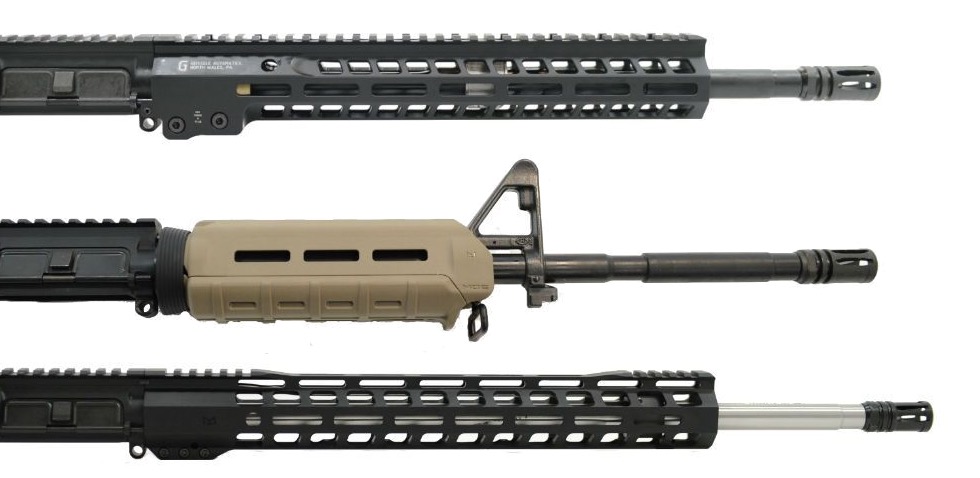This may come as a surprise, but the rifle barrel is undoubtably one of the most important parts of a good rifle setup, especially when precision shooting is desired. Of course there are other parts such as quality triggers and stocks which are vital, but the barrel is one component which is often overlooked by novice shooters as being of less importance; paying more attention to other flashy upgrades and accessories. So if you are in the market for a new rifle, then you may be wondering which barrel is best for accuracy and/or durability?
Unfortunately there is not one particular barrel that exceeds under all applications, but rather each barrel is designed for a specific purpose in mind. The choice typically comes down to one of two barrel materials – chrome-moly vs. stainless steel – with the option of a barrel lining or treatment for increased longevity.
Barrel Material Choices
- CHROME-MOLY – typically the most popular and affordable option, these barrels offer a longer barrel life than stainless steel, with decent accuracy. They are best suited for rifles which sustain rapid fire, with the ability to shoot further as well.
- STAINLESS STEEL – these barrels offer the best accuracy and precision all-round. They are slightly heavier and more costly than chrome-moly, and are most suitable for long range precision where rapid fire is less likely.
Barrel Treatment Choices
- NITRIDE (or MELONITE) COATED – ideal for semi-automatic rifle barrels made from chrome-moly or stainless steel. The process is more affordable than chrome-lining, increasing barrel longevity and corrosion resistance both inside and out.
- CHROME LINED – an expensive inner barrel lining applied to a chrome-moly barrel. While it reduces accuracy slightly – by roughly two-percent – it is the most effective treatment for mil-spec rifles which sustain extreme temperatures through rapid automatic fire.
In addition to materials and treatment, some shooters also concern themselves with the barrel’s manufacturing processes. Certain barrel manufacturing processes are more cost effective, while others offer superior quality. The most common and widely used today would be hammer forging and button rifling, whilst the older and more time consuming method would be cut rifling. But regardless of which method was used in creating a rifle barrel, it is – in my opinion – far more important to pay particular attention to the quality of materials used and the precision of the manufacturer, rather than focusing on how the barrel was made.
A good rifle with a bad barrel will not shoot with precision, but an average rifle with a good barrel and good bullet will be capable of both accuracy and precision.
Accuracy vs. Precision: What’s The Difference?
Since we have already given mention to both accuracy and precision, let’s clear things up by momentarily explaining the difference between the two, as accuracy and precision do not have the same meaning. Understanding the difference between accuracy and precision is fundamental in further developing your skills as a marksman.

Accuracy – this is defined as the ability to hit your aiming marker. In other words, your grouping (or bullet impact) is equal to your point of aim once accuracy has been achieved, and your bullet is landing exactly where you had planned.
Precision – this is the rifle’s ability to group well, consistently placing rounds as close together as possible. The tightness of a grouping measures the precision of a weapon, and the shooter’s consistency and skill.
By achieving a combination of both accuracy and precision consistently, you will have a weapon system capable of achieving a much higher hit percentage when engaging long range targets.
How Accurate Should a Rifle Barrel Be?
A rifle cannot be too accurate, but if manufactured to a poor standard, it can easily lack accuracy. As an acceptable minimum standard, it is quite common to be satisfied with a 1MOA rifle using factory ammunition. MOA stands for minute of angle, a system of units used to measure a rifle’s accuracy potential.
- Bolt-Action Barrels – it is common for bolt-actioned rifles with quality barrels to provide increased precision over their counterparts, often capable of achieving 1/2MOA consistently. These rifles will however rely on quality components and tuned ammunition.
- Semi-Automatic Rifle Barrels – AR-15’s and DMR’s offer less precision than bolt-actions, often striving to achieve consistent 1MOA groupings as a minimum – at least when long range shooting is applicable. If the rifle is to be used for home defence or close range shooting, then fine detail in accuracy shouldn’t be of too much concern.
Tip: when shopping around for a precision rifle or DMR of your own, always be aware of bargain rifles that advertise high quality specs; some manufacturers will prey on the lack of consumer knowledge. In these cases you would be better off buying a reputable entry level rifle and upgrading slowly as your budget and experience evolves.
Chrome-Moly vs. Stainless Steel Rifle Barrels
The Chrome-Moly Barrel – these barrels are made from chromium-molybdenum alloy – which is harder and stronger than steel – ultimately providing a longer barrel life expectancy. When made correctly, some say that they can be close in accuracy when compared to a stainless steel barrel, but not quite in the same league. Many believe that a chrome-moly barrel will hold its accuracy longer than a stainless steel barrel, thanks to the alloy’s superior ability to mitigate heat and friction. However, if not treated or coated, these barrels will require additional care over stainless steel in preventing rust and corrosion.
The Stainless Steel Barrel – the majority of quality match-grade barrels are made from stainless steel, which is softer and easier to intricately machine than their counterparts. This would make it easier for a gunsmith to apply a fine hand-lapped finish to the bore, removing the tiny imperfections that occur during bulk manufacturing. The stainless steel barrel is often said to be slightly heavier than a chrome-moly barrel, and is far less prone to corrosion. This barrel choice is regarded as the most accurate option, best suited for long range precision where rapid fire is less frequent.
Nitride [and Melonite] vs. Chrome Lined Rifle Barrels
Before we get into the differences between nitride and chrome lined barrels, it is important to understand that these coatings are added to chrome-moly and/or stainless steel barrels in order to drastically increase barrel life and resistance to both corrosion and abrasion. They both have their strengths and weaknesses, which we will discuss in more detail below.
Nitride Barrels – otherwise known as Melonite, Isonite or QPQ, this treatment is applied to both the internal and external barrel surfaces, and is more affordable than chrome lining while still offering similar levers of extended longevity. The pros and cons of nitrided barrels are as follows:
- The treatment drastically increases the lifespan of both chrome-moly and stainless steel barrels, particularly in semi-automatic rifles.
- Since the nitriding process is simpler than chrome lining, the cost of a new barrel is often lower.
- Both the internal and external barrel surfaces are treated, providing all-round protection against corrosion.
- Since the nitride is technically a treatment of the steel rather than an added lining, it tends to be more accurate, and can be applied to both chrome-moly and stainless steel barrels.
- Nitride treatment is not recommended on rifles that are intended to sustain heavy rates of fully-automatic fire, but are perfectly suitable for most semi-automatic rifles.
Chrome Lined Barrels – this process involves adding a layer of extremely resilient chrome to the barrels internal surfaces; the bore. The advantages and disadvantages of chrome lined barrels are as follows:
- The lining drastically increases the lifespan of chrome-moly barrels, but is considered far less suitable towards stainless steel barrels.
- It is marginally superior to nitriding – at least when it comes to extending barrel life – but it comes at a higher price.
- Since chrome lining is achieved by adding to the barrel’s surface rather than chemically treating it, accuracy is slightly diminished. Some say that a good chrome lining will reduce accuracy by around two-percent.
- The barrel’s exterior is left untreated, providing no outside surface resistance to corrosion. This typically requires another type of exterior protection such as blueing or parkerizing.
- Chrome lined barrels are far more resilient to fully-automatic fire (extremely rapid fire rates & high temperatures), which would otherwise see a nitride treatment outgas itself and leave the steel, becoming ineffective. This is primarily applicable to military use.
In addition to corrosion resistance and a reduction in barrel wear, both processes – nitride and chrome lining – both make cleaning and maintenance of the barrel a whole lot easier, and I would highly recommend one of these options on any semi-automatic rifle.
Conclusion
So what is the verdict; which barrel is best for you? My advice:
- If you’re after an extremely accurate bolt-action that requires serious precision – typically those who compete professionally – then a stainless steel barrel is the way to go.
- A hunting rifle or long range setup that is extremely capable and lightweight – consider chromy-moly. Just make sure you look after the barrel; keep it well oiled and regularly cleaned to prevent corrosion.
- Building (or purchasing) a tactical semi-automatic rifle or carbine? Give special consideration towards a chrome-moly or stainless steel barrel with Nitride treatment.
- And finally, if you intend on laying down continuous streams of fully automatic fire with a ton of mag dumps, then a chrome lined barrel will serve you well.


One thought on “Rifle Barrels 101: Which Barrels Are Best For Accuracy and Durability?”
We won two world wars with 4140 steel barrels in both the M1Garand, Bar, 1903 Springfield, M1Carbine, and much more!
Chrome lining becomes inaccurate very soon while a 4140 Melonite treated barrel is just fine. Your not going to dump loads of rounds in a combat situation even with a Colt M4A4 or anything else. I wouldn’t hesitate to go to battle with an AR like a Delton Mod 2 5.56 with a mil-spec upper and lower. Keep it lubed and cleaned and fire thee to five round bursts and it will keep going. The hype over 4150 is just that, hype to sell more upper end rifles.
A 700.00 dollar Del-Ton Sport 2, 5.56 for instance is an entry level rifle. Very reliable.
Through the range for qualification in a M16A4 configuration vs. a Colt or whatever, I guarantee it comes down to the shooter. Can’t beat a Del ton for the money. Shots as well as the Colts I carried since the 70’s. 26-years in the Marines and we shoot the crap out of our weapons.